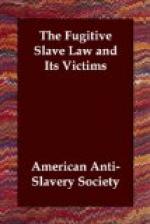of the day, without reference to party distinctions,
are the authorities relied upon in making up this
record, and the dates being given with each
case, the reader is enabled to verify the same, and
the few particulars which the compass of the Tract
allows to be given with each. With all the effort
which has been made to secure a good degree of completeness
and exactness, the present record must of necessity
be an imperfect one, and fall short of exhibiting
all the enormities of the Act in question.
JAMES HAMLET, of New York, September, 1850, was the first victim. He was surrendered by United States Commissioner Gardiner to the agent of one Mary Brown, of Baltimore, who claimed him as her slave. He was taken to Baltimore. An effort was immediately made to purchase his freedom, and in the existing state of the public feeling, the sum demanded by his mistress, $800, was quickly raised. Hamlet was brought back to New York with great rejoicings.
Near Bedford, Penn., October 1. Ten fugitives, from Virginia, were attacked in Pennsylvania—one mortally wounded, another dangerously. Next morning, both were captured. Five others entered a mountain hut, and begged relief. The woman supplied their wants. Her husband went out, procured assistance, captured the slaves, and received a reward of $255.
Harrisburg, Penn., October. Some slaves, number not stated, were brought before Commissioner M’Allister, when “the property was proven, and they were delivered to their masters, who took them back to Virginia, by railroad, without molestation.”
Detroit, 8th October. A negro was arrested under the new law, and sent to jail for a week, to await evidence. Great numbers of colored people armed themselves to rescue him. Result not known.
HENRY GARNETT, Philadelphia, arrested as the slave of Thomas P. Jones, of Cecil County, Maryland, and taken before Judge Grier, of the United States Supreme Court, October 18, 1850, who declared his determination to execute the law as he found it. The Judge said that the claimant had not taken the course prescribed by the fugitive act, and proceeded to explain, in a detailed manner, what the course should be in such cases. As the claimant thus failed to make out his case, the prisoner was ordered to be discharged.
Boston, about 25th October. Attempt to seize WILLIAM and ELLEN CRAFT. William Craft armed himself, and kept within his shop. Ellen was concealed in the house of a friend. Their claimants, named Hughes & Knight, were indicted for defamation of character, in calling W.C. a slave, and brought before a magistrate. The feeling excited against them was so great, that they at length fled from the city. Shortly after, it being considered hazardous for Mr. and Mrs. Craft to remain in the country, they were enabled to escape to England.




